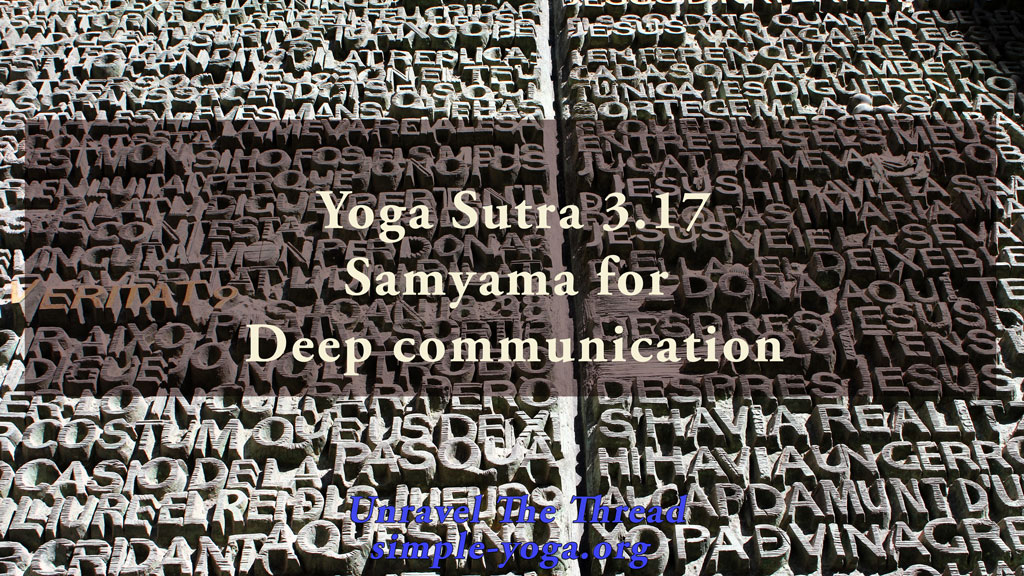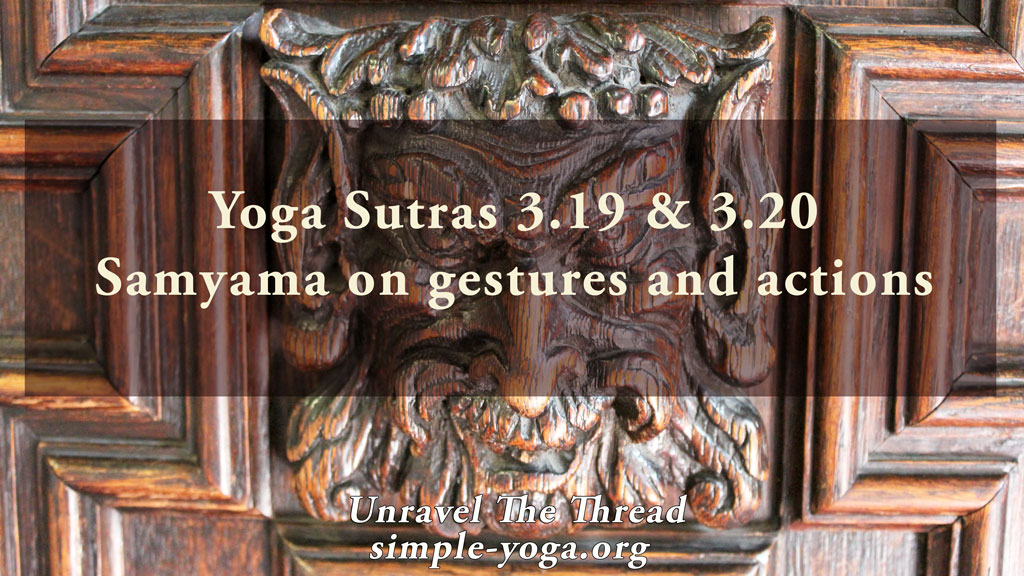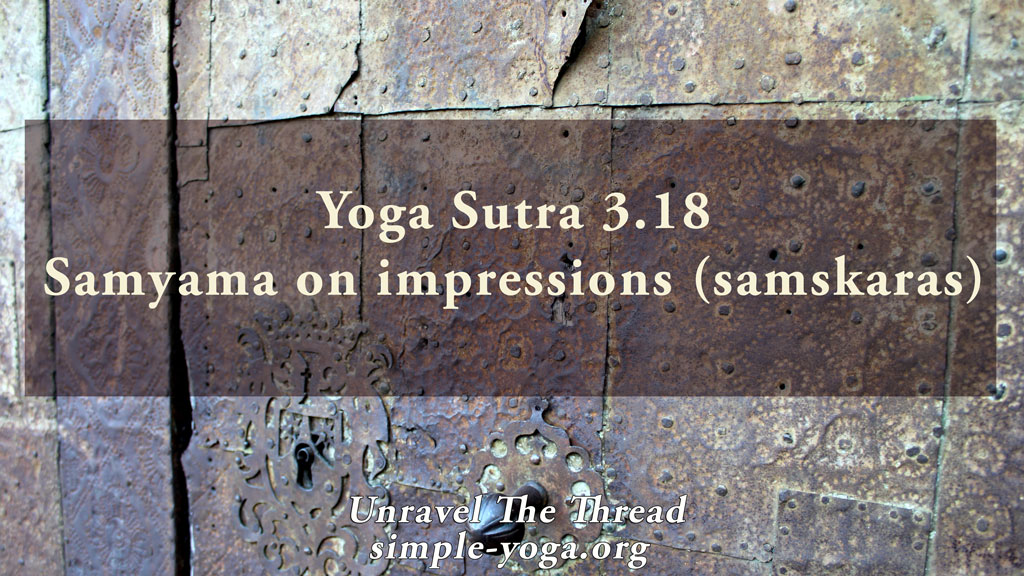
3.17 Samyama for Deep communication
September 4, 2021
3.19 and 3.20 Samyama on gestures and actions
September 18, 2021
3.17 Samyama for Deep communication
September 4, 2021
3.19 and 3.20 Samyama on gestures and actions
September 18, 20213.18 Samyama on impressions (samskaras)

3.18 Meditative integration (samyama) on impressions (samskaras) offers insight into previous births.
Samskaras are the impressions recorded in you because of the experiences you have. Some of those impressions are conscious, while others are unconscious. It appears as if emotion is one of the most powerful catalysts to embed the impressions into your space of awareness. As you reflect on your memories, notice how emotion contributed to deepen the hold of some of those memories. Emotion is expressed and felt in close connection to awareness, because emotion is energy that is active in the present moment. Emotion captures your attention. If the experience you are having comes to a balanced resolution, its emotional charge travels through you leaving an imprint as a memory that can bring that same feeling of buoyancy, spaciousness, and clarity. On the other hand, if the experience leaves an unresolved emotional residue, the energy that feeds that emotion attaches to you, triggering a similar feeling every time you remember that event. This emotional residue is stored regardless of it being positive or negative. This phenomenon may explain why sometimes there are some feelings that seem difficult to shed even though we consciously may try to convince ourselves that we do not want to keep ruminating about a past event that is long gone.
One very useful practice to try to turn these well-established habits is sitting with tolerable discomfort as it was mentioned briefly in the commentary about sutra 2.10. You may choose a recent event that seemed to trigger some tolerable discomfort, such as something that made you feel slightly embarrassed, anxious, or frustrated. Rather than focusing on the surface aspects of the experience choose to focus your attention on the actual sensations that you felt. This is easiest by recalling the event and its effects on your body, mind, and emotions. Instead of trying to come up with opinions, explanations, or solutions to the situation, use the sensations triggered by the event as your focal point. Concentrate upon those sensations and stay focused on them choosing to travel along the emotional dimension. Recall a previous event that generated the same overall feeling and reactivity, feel the tolerable discomfort without trying to figure it out, without attempting to numb it, medicate it or ignore it. This is important. Stay with your focal point and continue finding past experiences that cause you to feel this way. It may not be difficult to keep traveling to earlier and earlier parts of your life. Is it possible to find the earliest memory of feeling this way? Notice that this concentrated focus on emotion may be revealing that dissimilar situations tend to resonate emotionally in very similar ways within you. Could it be that the earliest memory is still somehow trapped within you, creating a sore spot that is quite sensitive because it has not been resolved? What happens if you sit with this tolerable discomfort and let it flow through you without trying to suffocate it or to ignore it? Can you allow this emotional energy to be used up instead of keeping it trapped within you? It may be necessary to make peace with the feelings within that trigger this response. Those feelings may include inadequacy, scarcity, fear, worry, anxiety as well as numerous others. Most likely the majority, if not all these feelings, conflict with the fundamental truth that you are complete and whole. The conflicting feeling may deny or obstruct your deep connection with the embrace of all-pervasive love, compassion and awareness that makes up all that exists. Can you surrender to this fundamental truth instead of believing in the inaccurate notion that you are isolated and in need of justification for your existence?
This practice can have profound effects on your relationship with yourself, and it is just a simple practice that asks you to confront deep-seated fears about your true nature. This practice is a productive way to harness the powers of samskaras to offer you insight into both your past and your present so that you are no longer at the mercy of past impressions controlling your thoughts, reactions and interactions now and in your future. If this is possible, might it also be feasible that practicing samyama into your deep-seated impressions may uncover even deeper connections to events beyond your current embodiment? In case that it might be possible to learn about your previous lives, rather than seeing what you find as a source of entertainment, the information you discover may provide you with useful insight into your current life and life purpose. For instance, if you realize that you have been alive before in a different body and different circumstances, what effect would that have on how you currently invest your awareness, energy and time?
As usual, one more way of exploring the meaning of this sutra is by chanting it.
You can choose to chant it in its traditional form with some of the words coming together:
3.18 saṃskārasākṣātkaraṇāt pūrvajātijñānam
संस्कारसाक्षात्करणात् पूर्वजातिज्ञानम् ॥१८॥
Another option is to chant each word in the sutra individually:
- saṃskāra
- sākṣāt
- karaṇāt
- pūrva
- jāti
- jñānam
If you prefer, you may listen to the podcast:
Unravel the thread is now available as a book!
If you find Simple-Yoga.org and Unravel the thread useful, consider supporting my labor with a donation, you may also donate using PayPal or Venmo. Thank you!
